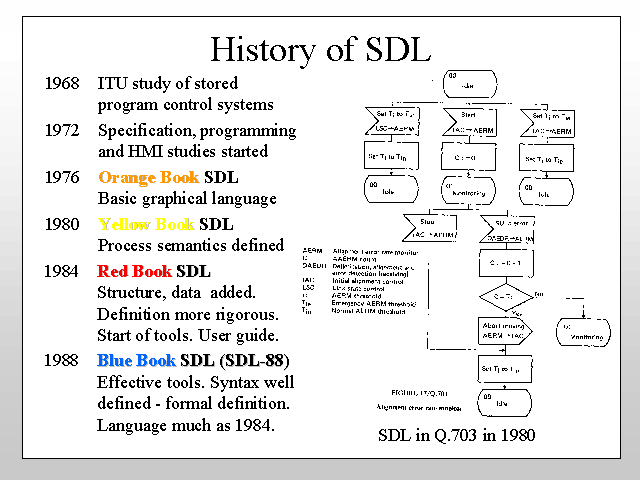Slide 2 of 14
Notes:
Although the SDL language is today a language applicable to the
specification and implementation of any real time system, it has its
origins in telecommunications. The development of SDL arose out of an
ITU study started 1968 of the way to handle stored programme control
switching systems. The result of this study was to agree in 1972 that
languages were needed for specification, programming and human machine
interaction. The first, small SDL standard was produced in 1976 as the
language for specification. SDL has been updated every four years, with
some updates being larger than others.
All ITU standards (called Recommendations – they recommend
norms to national bodies) are the result of collaborative work, and it
is widely recognised that the early 1980 SDL language owed much to
earlier work done by Göran Hemdal, Nils Lennmarker and Ivar Jacobson,
then of Ericsson. Much other input was included from ITU members
throughout the world. For example, in 1970 the main editor1 for
SDL-2000 was working at GEC Telecommunications with state transition
diagrams with “send/no wait” signal semantics very similar to SDL, and
GEC contributed to the ITU study.
Before 1984 SDL lacked data, which prevented it from being
used formally for most models, as these depended on data for decisions
and passing information. The initial data model added to SDL was based
on an algebraic approach from Australian contributions, notable from
Bob Pascoe then of RMIT. The 1984 language also had a more formal
definition with the separation of the concrete syntax, the abstract
syntax and a semantic model based on mathematical graphs, though the
model was described in natural language only at that time.
1988 saw the introduction of a formal definition for SDL in
VDM (alias Meta IV) to underpin the natural language description.
Anders Olsen, then of TeleDanmark and others did the bulk of this work.
1Rick Reed, TSE Limited, UK. One of the authors of this course material.

